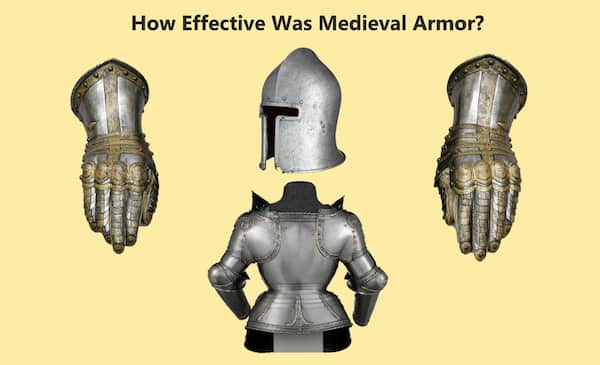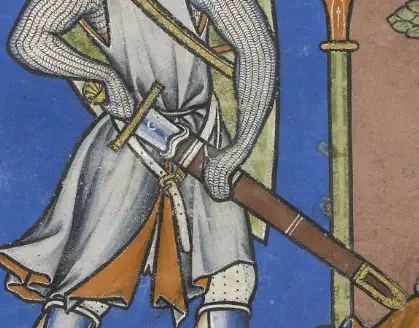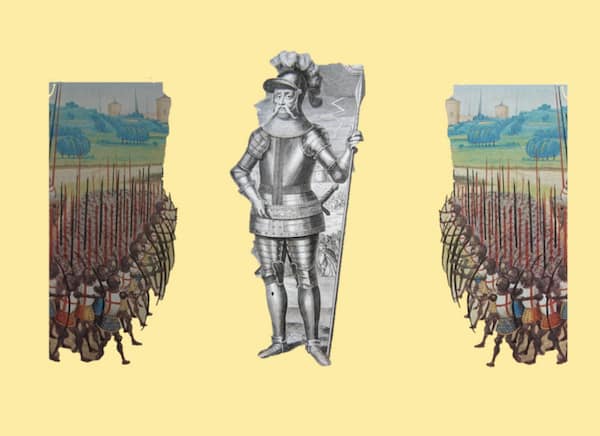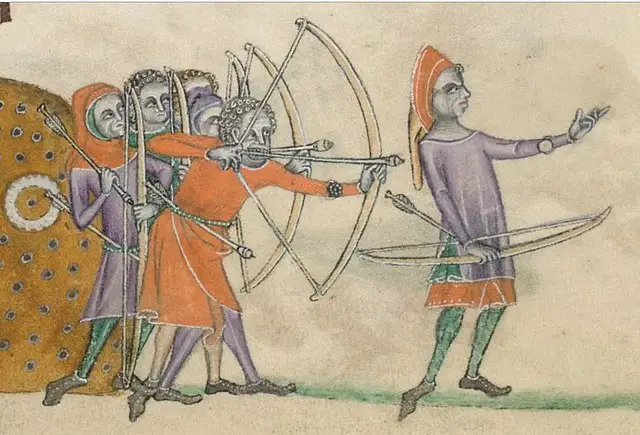
| Further Reading | The Heaviest Medieval Armor |
From the 5th century up to the end of the 16th century the medieval knight was nearly unstoppable. Clad in heavy iron and steel armor these knights were the equivalent of modern tanks on the battlefield. However, the question remains of just how effective was this medieval armor at protecting the knight?
Simply put, medieval armor made a knight nearly immune to swords, arrows, spears, and hammers. So effective was medieval armor that for nearly 1,000 years armor was the deciding factor in many medieval battles. It was not until the advent of gunpowder in the western world that armor began to decline. Simply put, a knight in full plate armor was almost invincible on the battlefield of medieval Europe.
Here at The History Ace, I strive to publish the best history articles on the internet. If at the end of this article, you enjoyed it then share it around and subscribe to our free newsletter.
Without further ado, here is just how effective medieval armor was at protecting the knight who was wearing it.
Medieval Armor’s Effectiveness At Blocking Swords

Medieval armor was extremely effective at blocking a normal sword from hurting the knight.
Most swords would simply bounce off a highly armored medieval knight. The reason behind this was because of just how most suits of medieval armor were made. A good set of medieval plate mail would have cost the knight a fortune and required round-the-clock maintenance to prevent rust and other forms of damage.
This would have been extremely costly for the knight to maintain but it was well worth it. Platemail was more than capable of either blocking or deflecting swords due to how it was built.
Platemail armor was built using several pieces of thick metal that were pressed down and layered on top of each other. These layers were then built to resemble an exoskeleton of a knight. When all the armor pieces were worn the medieval knight was covered from head to toe in iron plates.
Each of these iron plates was built to be able to prevent the cut from any slashing weapon like a sword. While the impact from the sword would have still been felt the knight would have been left unhurt from a sword impact.
The best medieval suits of plate armor were even capable of deflecting sword blows away from the knight instead of absorbing them. If you were fighting against a medieval knight this would have made them seem unstoppable as your sword just glanced off them.
As such, the effectiveness of medieval armor in block sword slashes was nearly absolute. You would have had to get extremely lucky to hurt a knight in full armor by slashing your sword.
Medieval Armor’s Effectiveness At Blocking Spears

The weapon that a medieval knight would most likely come into contact with while in the field was a spear. This was because spears were easy to manufacture and allowed large armies to push in unison. Swords on the other hand were designed for when the enemy got within the distance of a spear.
As such, medieval armor was designed to withstand the puncturing power of a traditional spear. This was where good medieval armor was worth its weight in gold as badly made armor would fail to protect the knight against a spear.
Low-quality medieval armor would simply attempt to block a direct hit from a spear. This was often done by having the plate armor reinforced with heavy cloth garments such as a gambeson underneath it. However, this often failed to protect the knight fully and would leave them exposed in several gaps in the armor.
The best-made medieval suits of armor were designed to deflect direct spear attacks by making the chest piece of the armor pointed. This concaved part of the armor would cause any spear point to deflect away from the knight. However, if the suit of armor was not made properly this deflected spear point could get wedged into the armor and still inflict damage.
This is why the quality of the armor was so important. High-quality medieval armor was extremely efficient at blocking spears and other piercing types of attacks. Low-quality armor on the other hand would hardly protect the knight and would fail.
Medieval Armor’s Effectiveness At Blocking Arrows

It was not just melee weapons that the knight’s armor was efficient at blocking. Arrows and even some crossbow bolts would bounce off a high-quality set of medieval armor.
Arrows and crossbow bolts remained one of the main reasons why a knight would invest heavily into a set of high-quality armor. Heavy medieval armor that was crafted properly was more than capable of blocking general arrows. Crossbow bolts were harder for medieval armor to block but even a well-made set of armor was efficient at preventing any damage from a crossbow.
A knight in full armor was extremely efficient at surviving a hailstorm of arrows being launched at them. It was not until the longbow started to get used in the late medieval period that knights started to have to seek extra protection from arrows. This was where the heater shield came in and helped to further increase the efficiency of medieval armor.
However, for most of medieval Europe armor was more than capable of blocking and negating any form of arrow damage to the knight. This was because most of the armor sets of this time would feature a protruded breastplate that helped to push the arrows to the side and around the knight’s body. This type of medieval armor helped to increase the efficiency of the armor at blocking any form of damage caused by arrows to the knight.
Conclusion
There you have it; an entire article going over just how efficient the average set of medieval armor was at protecting knights.
Generally speaking, there were many types of medieval armor sets. Some of the basic sets were just leather or heavy cloth shirts that offered hardly any protection. However, for a knight there existed armor sets that were so efficient at protecting the body that they were practically invincible. The technology behind medieval armor and weapons was always a game of cat and mouse where a new weapon was invented and then armor would be invented to counteract it. This trend continued for the entire length of the medieval ages up until the adoption of the firearm during the 17th century.
I hope you enjoyed this article on just how efficient medieval armor was. Here at The History Ace, I strive to publish the best history articles on the internet. Feel free to share around the web and subscribe to the free newsletter.
Further, you can check out some of the other articles below.
-
The Extreme Effectiveness of Medieval Armor Explained

Just how effective was medieval armor? Well here is the answer to just how much protection a set of medieval plate armor offered the knight.


